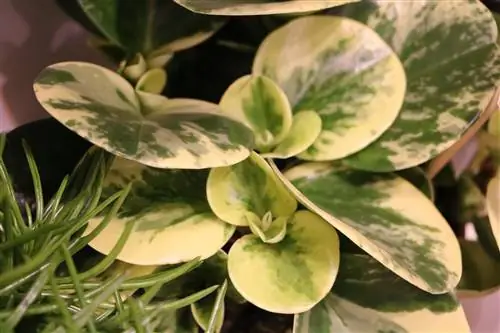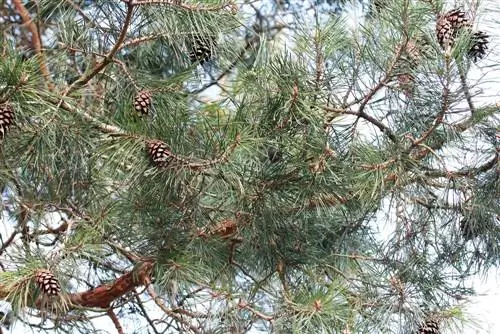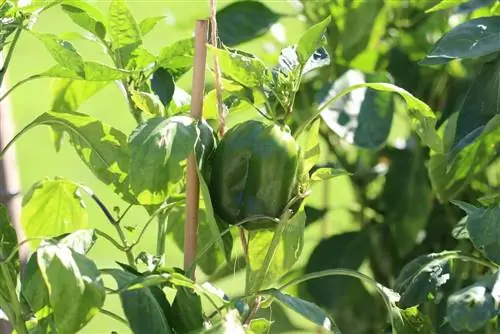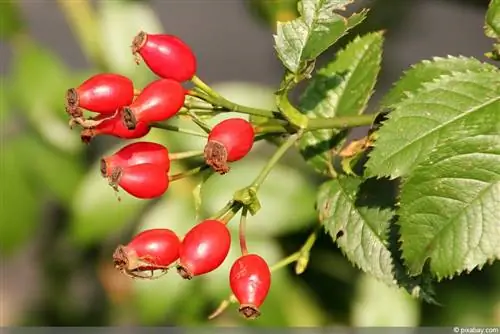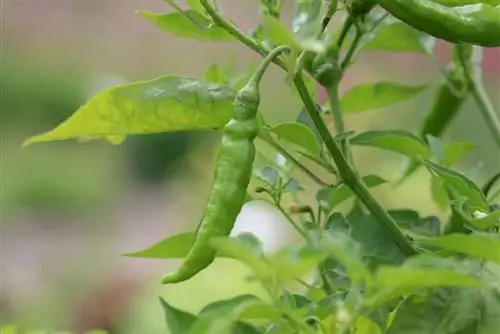- Author admin [email protected].
- Public 2023-12-17 03:39.
- Last modified 2025-01-24 12:45.
The dwarf pepper is a robust houseplant that is often found under the botanical name Peperomia. However, due to the different breeds, the plants can sometimes differ greatly from one another in shape, color, size and leaf structure.
However, the flowers of the Peperomia are very characteristic, so that you can easily recognize the dwarf pepper from them, because most species produce long, thin, mostly white to cream-colored flower spikes.
Peperomia species diversity
Since it is crucial for proper care and keeping which type of dwarf pepper you have in your home, you will first find the most well-known varieties here so that you can identify which plant your plant is.
- Peperomia argyreia is very popular and therefore widespread. It produces thick, fleshy leaves with a smooth surface. The broad, egg-shaped leaves converge to a point at the end of the leaf and are easily recognizable by the silver leaf grain and the dark green leaf edges.
- The Peperomia caperata is completely different with its heart-shaped, dark green leaves with a strongly wavy surface. In the depressions of these waves, the green color appears almost black and, together with the reddish to pinkish-red petioles, gives the plant a richly contrasting color. Under good conditions, they produce white flower spikes of different lengths from summer to autumn.
- The Peperomia fraseri also produces small heart-shaped leaves, but they are red on the underside. However, the flower spikes, arranged in clusters and up to 65 cm high, are also striking.
- If the dwarf pepper has medium green colored and oval-shaped leaves with a pink petiole, it is certainly Peperomia glabella. This species develops its shoots primarily laterally and therefore reaches a height of just 15 cm.
- The Peperomia griseoargentea also only reaches a height of around 15 centimeters. However, the leaves are grayish green and have a silvery sheen and darker veins. However, like the glabella, the petioles are pink. With the greenish white flower spikes, this variety reaches a height of almost 25 cm.
- Peperomia obtusifolia is also very widespread with its fleshy and dull shiny leaves, which are recognizable by their elliptical shape and dark purple-green leaves with a blunt tip. If kept well, it produces umbels of around 7 cm long flowers from late spring to autumn.
- Peperomia obtusifolia is often confused with obtusifolia 'Alba'! Although these two species have the same growth habit, they differ in the coloring of the new shoots. In the case of obtusifolia “Alba”, the shoots that grow back are characterized by a light yellow color, which only later turn a rich green. The obtusifolia of the same name 'Alba-marginata' with its silver-white leaf edge and gray-green leaf color stands out much better.
There are over 1,000 Peperomia species. Many are popular houseplants. Those with variegated or brightly colored leaves are particularly popular. Peperomia caperata schumi red, for example, has striking dark red leaves. Peperomia asperula, Peperomia bibi, Peperomia columella, Peperomia magnoliifolia, Peperomia meridana, Peperomia rotundifolia and Peperomia verticillata are often offered.
Location for dwarf pepper
If you have been able to find your dwarf pepper in the species described above, that is even better when looking for a suitable location! However, there are also general rules of thumb that you can follow when looking for a location. If the dwarf pepper is characterized by pure green leaves, a bright location with some morning or evening sun is ideal. However, these plants do not like direct sunlight from the midday sun. Variegated species are much tougher and can cope with strong sunlight, although it certainly doesn't hurt if they are shaded a little.
Watering Peperomia
The dwarf pepper is a very undemanding plant, which is not least due to its delicate and rather small shape. It is therefore better to be economical when watering. It does not harm the plants if the soil dries out a little between watering sessions. Dwarf pepper species with fleshy leaves store a small supply in their leaves anyway, which is why they survive such short dry periods very well. These plants cannot tolerate too much water. You can tell this when the dwarf pepper loses its leaves. Permanent overwatering usually even leads to the death of the plant.
Fertilize Peperomia
During the growth phases, i.e. from spring to autumn, you can water the plants about every 4 weeks with a low-dose fertilizer solution. However, you should not overdo it, as excessive fertilization can lead to unnaturally soft growth of the plant.
Ambient temperature for dwarf pepper
The dwarf pepper actually doesn't have any great demands on the temperature of its environment, so it can safely be kept at a normal room temperature. However, in order for it to thrive, the temperature should not be below 12 °C. High humidity can have a positive effect on growth, which is why a place directly next to the heater is rather unsuitable. If the air is too dry, pest infestation and dried leaf edges can result.
Repotting and Pruning
Due to the dwarf pepper's small growth, the roots of most Peperomia are relatively small and slender, so they can be kept very well in small planters, pots, hanging baskets or shallow planting bowls. However, depending on your needs, you can safely repot them in the spring. A peat-based soil mixture is suitable here. However, in order to avoid waterlogging, the planters should either be perforated or lined with pebbles.
Once you're over repotting, the shoot tips should also be broken out to encourage the development of new side shoots. This usually results in bushy growth. Hanging dwarf pepper varieties, on the other hand, can be cut back by a third of their total length in spring to give the shoots new strength.
Propagation of the dwarf pepper
If you want to propagate your dwarf pepper, you can do this in the form of head cuttings. To do this, cut off shoots about 5-8 cm long below a leaf node, remove the lower leaves and place them in a glass of water to root. Later you can plant the early cuttings in groups of 7-10 in a peat-sand mixture. If you want to plant the cuttings in the glass without pre-rooting, a transparent plastic bag should be placed over the planter after lightly watering in order to keep the moisture as constant as possible. Temperatures around 18 °C are ideal for rooting. In a bright location, the rooting phase lasts approximately 4-6 weeks.
Dwarf pepper species such as Peperomia argyreia, caperata or griseoargentea can also be propagated very well using leaf cuttings. To do this, young and well-developed leaves with a stem approximately 2 cm long up to the leaf blade are placed in a slightly moistened substrate made of sand and peat. The rooting phase lasts approximately 8-10 weeks. During this time, the leaf cuttings should be watered regularly, but also allowed to dry out a little from time to time.
What you should know about the dwarf pepper in brief
The Peperomia plants are a genus with quite different specimens. There are around a thousand species. Although they are all low-growing plants, they sometimes differ considerably in size, shape, color and structure. Peperomia is also known as dwarf pepper, ornamental pepper or pepper family. Climbing species are well suited as hanging plants.
Tip:
Peperomia species are very popular with terrarium owners. The plants are non-toxic and don't mind being eaten.
Location tips
- The exclusively green-leaved species of Peperomia are more sensitive than those with colorful leaves.
- Both species need a bright place. However, the green-leaved specimens do not tolerate sunlight.
- Although they can stand in the morning or evening sun, midday sun should be absolutely avoided.
- The variegated species have no problem with the sun. However, you should still avoid the blazing midday sun.
- A location that is too dark causes the variegated species to lose their beautiful coloring. The leaves turn green.
- The Peperomia thrive well at normal room temperatures. They should not be stored below 12 °C.
Tips for substrate and watering
- The planting substrate should contain peat. Basically, normal potting soil is also suitable.
- Drainage at the bottom of the pot is always important. A mixture of potting soil, sand and pumice gravel in equal parts is ideal.
- Humus is also good for mixing in. Peperomia do not require a lot of water. They need to be watered sparingly.
- The soil must always dry thoroughly between waterings. Constantly moist plant substrate is harmful to the plants.
- They often lose their leaves or the roots rot, then there is hardly any chance of saving them.
- Drought, on the other hand, does little harm because the leaves can store a lot of water.
- Peperomia love high humidity, this is the only way they can thrive.
- This is especially important for soft-leaved species. So you should spray the plant regularly with water.
- If the air is too dry, there is a risk of pest infestation.
Tips against pests
- Pests include the red spider or spider mites.
- Both cover the leaves and the leaf axils with a fine web.
- Usually only chemical treatment helps to get rid of the little animals.

